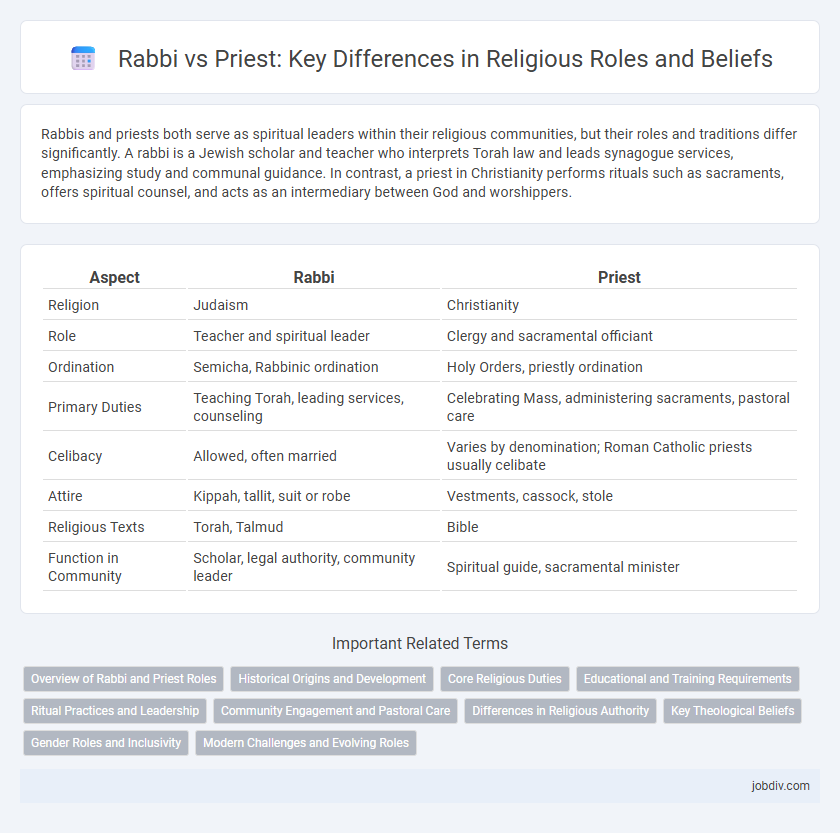Rabbis and priests both serve as spiritual leaders within their religious communities, but their roles and traditions differ significantly. A rabbi is a Jewish scholar and teacher who interprets Torah law and leads synagogue services, emphasizing study and communal guidance. In contrast, a priest in Christianity performs rituals such as sacraments, offers spiritual counsel, and acts as an intermediary between God and worshippers.
Table of Comparison
| Aspect | Rabbi | Priest |
|---|---|---|
| Religion | Judaism | Christianity |
| Role | Teacher and spiritual leader | Clergy and sacramental officiant |
| Ordination | Semicha, Rabbinic ordination | Holy Orders, priestly ordination |
| Primary Duties | Teaching Torah, leading services, counseling | Celebrating Mass, administering sacraments, pastoral care |
| Celibacy | Allowed, often married | Varies by denomination; Roman Catholic priests usually celibate |
| Attire | Kippah, tallit, suit or robe | Vestments, cassock, stole |
| Religious Texts | Torah, Talmud | Bible |
| Function in Community | Scholar, legal authority, community leader | Spiritual guide, sacramental minister |
Overview of Rabbi and Priest Roles
Rabbis serve as Jewish spiritual leaders, educators, and interpreters of Torah law, guiding their communities in religious practices and ethical living. Priests, particularly in Christian and ancient Jewish contexts, perform sacramental duties, lead worship services, and act as mediators between the divine and congregants. Both roles are central to religious life, but rabbis emphasize teaching and legal interpretation, while priests prioritize ritual and sacramental functions.
Historical Origins and Development
Rabbi and priest roles emerged from distinct religious traditions, with priests originating in ancient Jewish temple worship responsible for sacrificial rituals, especially during the First and Second Temples period. Rabbis developed later as teachers and interpreters of Jewish law (Halakha), rising in prominence after the destruction of the Second Temple in 70 CE, shifting focus from temple rites to Torah study and community leadership. This historical evolution reflects a transition from ritual-based priesthood to scholarly authority within Judaism.
Core Religious Duties
Rabbis primarily interpret Jewish law, lead synagogue services, and provide spiritual guidance within the Jewish community. Priests perform sacramental rites, oversee liturgical ceremonies, and mediate between God and congregation in Christian traditions. Both serve as religious leaders but their core duties reflect distinct theological frameworks and rituals unique to Judaism and Christianity.
Educational and Training Requirements
Rabbis undergo extensive study of the Torah, Talmud, Hebrew language, and Jewish law, often completing several years at a yeshiva or rabbinical seminary before ordination. Priests typically attend a seminary where they study theology, biblical studies, church history, and pastoral care, culminating in ordination after several years of academic and spiritual training. Both roles require rigorous education but differ significantly in curriculum focus and religious texts studied.
Ritual Practices and Leadership
Rabbis primarily lead Jewish communities by interpreting Torah laws and guiding religious rituals such as Torah readings, lifecycle events, and Sabbath observances. Priests, specifically in Christian and ancient Hebrew contexts, perform sacrificial rites, lead liturgical ceremonies, and serve as mediators between God and worshippers. While rabbis emphasize teaching and legal scholarship, priests focus on ritual purity and sacramental leadership within their congregations.
Community Engagement and Pastoral Care
Rabbis serve as spiritual leaders within Jewish communities, providing personalized pastoral care through study, counseling, and guiding religious practices. Priests in Christian traditions perform sacramental duties and lead congregational worship, offering spiritual support and community outreach programs. Both roles emphasize community engagement, but rabbis often focus on teaching and dialogue, while priests prioritize liturgical leadership and administering sacraments.
Differences in Religious Authority
Rabbis derive their religious authority from extensive study of Jewish law (Halacha) and communal consensus, serving primarily as teachers and interpreters of scripture rather than intermediaries between God and people. Priests, particularly within Christian and Catholic traditions, hold sacramental authority inherited through apostolic succession, performing rituals such as the Eucharist and acting as mediators in worship. While rabbis emphasize legal scholarship and ethical guidance, priests focus on sacramental duties and liturgical leadership, reflecting fundamental differences in religious roles and authority structures.
Key Theological Beliefs
Rabbis in Judaism serve primarily as teachers and interpreters of the Torah, emphasizing study, prayer, and adherence to Jewish law (Halacha) without performing sacrificial rites. Priests in Christianity often act as mediators between God and people, administering sacraments like the Eucharist and offering prayers on behalf of the congregation. The core theological distinction lies in the rabbinic focus on covenantal law and communal teaching versus the priestly role centered on sacramental mediation and pastoral authority.
Gender Roles and Inclusivity
Rabbi roles in Judaism traditionally allow both men and women to serve, reflecting a growing movement toward gender inclusivity within many Jewish denominations. In contrast, the Catholic priesthood remains predominantly male, adhering to doctrinal teachings that restrict ordination to men. The evolving inclusivity in rabbinical leadership highlights significant differences in how gender roles are interpreted and practiced across these religious traditions.
Modern Challenges and Evolving Roles
Rabbinic leadership faces modern challenges like addressing secularism and interfaith dialogue, requiring adaptability in traditional Jewish law interpretation. Priests confront evolving societal expectations around inclusivity and LGBTQ+ issues, prompting shifts in pastoral care and community engagement. Both roles increasingly embrace technology and social media to maintain relevance and foster spiritual connection in contemporary faith communities.
Rabbi vs Priest Infographic

 jobdiv.com
jobdiv.com